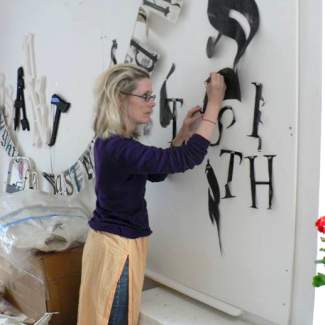Creating a Living Legacy: Lesley Dill
Lesley Dill

Can you share what has changed for you as a result of being a part of the CALL program?
When this process began 2 years ago there was virtually no archive of my work in my own studio. My art ranges over many mediums from sculpture, to photography, to printmaking, to performance, to community projects. Each medium has different sub categories, different tools to make the work, different raw materials for each process. For example, in the sculpture category I use horsehair, thread, bronze, fabric, wire, flat metal, oil pastels, paper, wood, paint, glue. In the performance category I have done projects from an intimate 5 person performance such as “Dada Poem Wedding Dress” done at Webster Hall in 1996, to “Divide Light” 2008, an opera conceived and directed by me and based on the poetry of E. Dickinson incorporating over 75 people. I have co-composed 3 other musical pieces. Each of these performances has costumes, photos, DVDs, CDs. My work is stored in over 7 locations around the NYC area. I work with two galleries and am fortunate to be having steady one person exhibits and numerous and growing traveling exhibits. I now have my own archiving system that helps me feel confident in keeping track of where things are and of being a good partner to the galleries and museums I work with.
I now have this incredible career documentation that has organized, inventoried, and archived most of my 2,300 art works. As developed by the Joan Mitchell Foundation CALL program, I have been given a concrete computer system as well as an education in a way of thinking that will further this process as I move into the future.
Can you give us a sense of what needed to be accomplished when you started working with the CALL Program?
The first thing to be accomplished was I had to perceive the need for all the above to happen. I had to make room for my mind to be open to this restructuring informational process and not make art, art, art every minute. Before working with CALL Legacy Specialists Rose Nestler and Natalie Beall, my computer was filled with incomplete and often inaccurate information. As an artist who uses text in every artwork it is an ongoing process to make sure every piece has its language archived. We also had to go to my upstate storage and completely re-organize my storage up there, as well as list where all other artworks exist. Also, we have been trying to track down artwork that only has lo-res photos or even, no photos at all. We are trying to get hi-res photos of as much work as possible.
What has been the most rewarding aspect of this work?
The most rewarding aspect is the feeling of confidence I have in the organization of my art works. I learned so much by listening to and watching Rose and Natalie work, bit by bit, slowly and steadily. Their devotion and generosity has been a gift. As a result, my work will now be more available to curators, writers, anyone interested in working with my work. I am very very grateful to the Joan Mitchell Foundation and the CALL Program. Honestly, without being part of this program I don’t know that I would comprehend where to even start.
What has been most difficult?
The most difficult thing for me was really realizing the necessity of being responsible to my work. After the realization came the commitment to giving time, to letting the archiving work happen, not only in the last two years but in looking ahead.
What do you recommend to artists who might be in the early stages of creating an inventorying system?
Hi-res & lo-res of each art work, information as to materials and dimensions of each work, information on where it is located, a computer system that will allow this information to be inputted and worked with, a calm mind.





